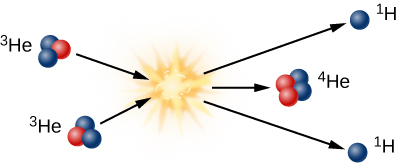| << Chapter < Page | Chapter >> Page > |
The second step in forming helium from hydrogen is to add another proton to the deuterium nucleus to create a helium nucleus that contains two protons and one neutron ( [link] ). In the process, some mass is again lost and more gamma radiation is emitted. Such a nucleus is helium because an element is defined by its number of protons; any nucleus with two protons is called helium. But this form of helium, which we call helium-3 (and write in shorthand as 3 He) is not the isotope we see in the Sun’s atmosphere or on Earth. That helium has two neutrons and two protons and hence is called helium-4 ( 4 He).
To get to helium-4 in the Sun, helium-3 must combine with another helium-3 in the third step of fusion (illustrated in [link] ). Note that two energetic protons are left over from this step; each of them comes out of the reaction ready to collide with other protons and to start step 1 in the chain of reactions all over again.

These animations of proton-proton reactions show the steps required for fusion of hydrogen into helium in the Sun.
Visit the Tokamak Fusion Reactor at the General Atomics Lab in San Diego, CA, for an 8-minute tour.
The nuclear reactions in the Sun that we have been discussing can be described succinctly through the following nuclear formulas:
Here, the superscripts indicate the total number of neutrons plus protons in the nucleus, e + is the positron, v is the neutrino, and γ indicates that gamma rays are emitted. Note that the third step requires two helium-3 nuclei to start; the first two steps must happen twice before the third step can occur.
Although, as we discussed, the first step in this chain of reactions is very difficult and generally takes a long time, the other steps happen more quickly. After the deuterium nucleus is formed, it survives an average of only about 6 seconds before being converted into 3 He. About a million years after that (on average), the 3 He nucleus will combine with another to form 4 He.
We can compute the amount of energy these reactions generate by calculating the difference in the initial and final masses. The masses of hydrogen and helium atoms in the units normally used by scientists are 1.007825 u and 4.00268 u , respectively. (The unit of mass, u , is defined to be 1/12 the mass of an atom of carbon, or approximately the mass of a proton.) Here, we include the mass of the entire atom, not just the nucleus, because electrons are involved as well. When hydrogen is converted into helium, two positrons are created (remember, the first step happens twice), and these are annihilated with two free electrons, adding to the energy produced.

Notification Switch
Would you like to follow the 'Astronomy' conversation and receive update notifications?